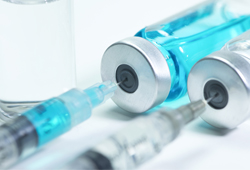 Last week, FDA released a draft guidance, “Labeling for Biosimilar and Interchangeable Biosimilar Products” that—when finalized—will revise and replace its July 2018 final guidance, “Labeling for Biosimilar Products.” FDA noted that this 2023 Draft Guidance reflects recommendations based on the “valuable experience about labeling considerations” that FDA has gained through its approval of 42 biosimilar products, including four interchangeable biosimilar products.
Last week, FDA released a draft guidance, “Labeling for Biosimilar and Interchangeable Biosimilar Products” that—when finalized—will revise and replace its July 2018 final guidance, “Labeling for Biosimilar Products.” FDA noted that this 2023 Draft Guidance reflects recommendations based on the “valuable experience about labeling considerations” that FDA has gained through its approval of 42 biosimilar products, including four interchangeable biosimilar products.
Notably, the 2023 Draft Guidance provides further recommendations regarding when to use a biosimilar or interchangeable biosimilar product name, and when to use the reference product name in labeling:
- The biosimilar or interchangeable biosimilar product’s proprietary name[1] (or if the product does not have a proprietary name, its proper name[2]) should be used when –
- Information in the labeling is specific to the biosimilar (or interchangeable biosimilar) product, including such references to the product in the INDICATIONS AND USAGE, DOSAGE AND ADMINISTRATION, DESCRIPTION, and HOW SUPPLIED/STORAGE AND HANDLING sections, and/or
- For “directive statements and recommendations for preventing, monitoring, managing, or mitigating risk,” including such references to the product in the BOXED WARNING, CONTRAINDICATIONS, WARNINGS AND PRECAUTIONS, and DRUG INTERACTIONS sections.
- When referring to the drug substance in the labeling, the biosimilar or interchangeable biosimilar product’s proper name should be used.
- When information specific to the reference product is described in the biosimilar or interchangeable biosimilar product’s labeling (for example, data from clinical trials of the reference product in the ADVERSE REACTIONS and CLINICAL STUDIES sections), the reference product’s proper name should be used.
- In sections of the labeling containing information that applies to both the biosimilar (or interchangeable biosimilar) product and the reference product—such as BOXED WARNING, CONTRAINDICATIONS, WARNINGS AND PRECAUTIONS, ADVERSE REACTIONS—the labeling should use the core name of the reference product followed by the word “products.”[3]
FDA acknowledges that the application of these recommendations is highly context-dependent and may not always be clear, but recommends that biosimilar and interchangeable biosimilar product sponsors evaluate all statements in product labeling carefully to determine the most appropriate product identification approach in each instance.
Another noteworthy aspect of the 2023 Draft Guidance is the Agency’s recommendation regarding the biosimilarity statement and footnote in the HIGHLIGHTS section of a biosimilar or interchangeable biosimilar product’s labeling.[4] Previously, FDA recommended a biosimilarity statement for a biosimilar product and an interchangeability statement for an interchangeable biosimilar product. The 2023 Draft Guidance now recommends a statement and footnote in the HIGHLIGHTS section that the product is biosimilar to the reference product, regardless of whether the product is a biosimilar or an interchangeable biosimilar to the reference product. In the Federal Register notice announcing the 2023 Draft Guidance, FDA acknowledges that this marks an “evolution in our thinking” and explains that “a labeling statement noting that certain products within a 351(k) [Biologics License Application] have been approved as interchangeable, and explaining the interchangeability standard, is not likely to be useful to prescribers, who can prescribe both biosimilar and interchangeable biosimilar products in place of the reference product with equal confidence that they are as safe and effective as their reference products.” FDA further states that “information about interchangeability is more appropriately located in the Purple Book rather than labeling.”
Other notable elements of the 2023 Draft Guidance include recommendations regarding how to describe pediatric use data in a range of scenarios and how to incorporate immunogenicity data. With respect to immunogenicity data, the 2023 Draft Guidance suggests that a contextual paragraph[5] generally be included in the relevant CLINICAL PHARMACOLOGY subsection before describing the available immunogenicity data for the reference product and the biosimilar or interchangeable biosimilar product. The 2023 Draft Guidance also outlines the Agency’s expectations for patient labeling—such as a Medication Guide, Patient Information, or Instructions for Use—for a biosimilar or interchangeable biosimilar product, if the reference product has such patient labeling.
Information on how to submit comments on the 2023 Draft Guidance can be found at https://www.regulations.gov/docket/FDA-2016-D-0643.
____________________________________________________________________________________________
[1] The proprietary name of a biosimilar product is a brand name determined by the sponsor. The fictitious example provided in the 2023 Draft Guidance is “NEXSYMEO.”
[2] The proper name of a biosimilar product is the nonproprietary name designated by FDA that consists of a biological product’s core name plus a unique four-letter suffix. The fictitious example provided in the 2023 Draft Guidance is “replicamab-cznm.”
[3] The fictitious example provided by FDA in the 2023 Draft Guidance is “replicamab products”.
[4] The fictitious example provided by FDA in the 2023 Draft Guidance is “NEXSYMEO (replicamab-cznm) is biosimilar* to JUNEXANT (replicamab-hjxf)” and the accompanying footnote is “Biosimilar means that the biological product is approved based on data demonstrating that it is highly similar to an FDA-approved biological product, known as a reference product, and that there are no clinically meaningful differences between the biosimilar product and the reference product. Biosimilarity of [BIOSIMILAR OR INTERCHANGEABLE BIOSIMILAR PRODUCT’S PROPRIETARY NAME] has been demonstrated for the condition(s) of use (e.g., indication(s), dosing regimen(s)), strength(s), dosage form(s), and route(s) of administration) described in its Full Prescribing Information.”
[5] The Agency’s suggested paragraph is, “The observed incidence of anti-drug antibodies is highly dependent on the sensitivity and specificity of the assay. Differences in assay methods preclude meaningful comparisons of the incidence of anti-drug antibodies in the studies described below with the incidence of anti-drug antibodies in other studies, including those of [proper name of reference product] or of other [core name] products.”

 Our Life Sciences Regulatory & Compliance team has launched a new resource page, keeping you up-to-date on the latest regulatory developments affecting laboratory developed tests (LDTs). Our dedicated LDT page provides foundational materials, legislative and regulatory history, and updates and analyses regarding initiatives to increase oversight over LDTs, including FDA’s LDT Proposed Rule (October 2020). Our Life Sciences Regulatory & Compliance team will continue to keep this page updated with the latest happenings.
Our Life Sciences Regulatory & Compliance team has launched a new resource page, keeping you up-to-date on the latest regulatory developments affecting laboratory developed tests (LDTs). Our dedicated LDT page provides foundational materials, legislative and regulatory history, and updates and analyses regarding initiatives to increase oversight over LDTs, including FDA’s LDT Proposed Rule (October 2020). Our Life Sciences Regulatory & Compliance team will continue to keep this page updated with the latest happenings. Last month, FDA issued a
Last month, FDA issued a  The U.S. Food and Drug Administration (FDA) has announced an upcoming
The U.S. Food and Drug Administration (FDA) has announced an upcoming  After an over decade-long discourse amongst interested stakeholders, on October 3, 2023, FDA unveiled its
After an over decade-long discourse amongst interested stakeholders, on October 3, 2023, FDA unveiled its 

 Last week,
Last week,  On September 6, 2023, the US Food and Drug Administration (FDA) released a trio of draft guidances in its efforts to “strengthen and modernize” the 510(k) Program and provide for more “predictability, consistency, and transparency” for the 510(k) premarket review process. In this post, we discuss the two new draft guidances with broad applicability to the 510(k) Program:
On September 6, 2023, the US Food and Drug Administration (FDA) released a trio of draft guidances in its efforts to “strengthen and modernize” the 510(k) Program and provide for more “predictability, consistency, and transparency” for the 510(k) premarket review process. In this post, we discuss the two new draft guidances with broad applicability to the 510(k) Program: